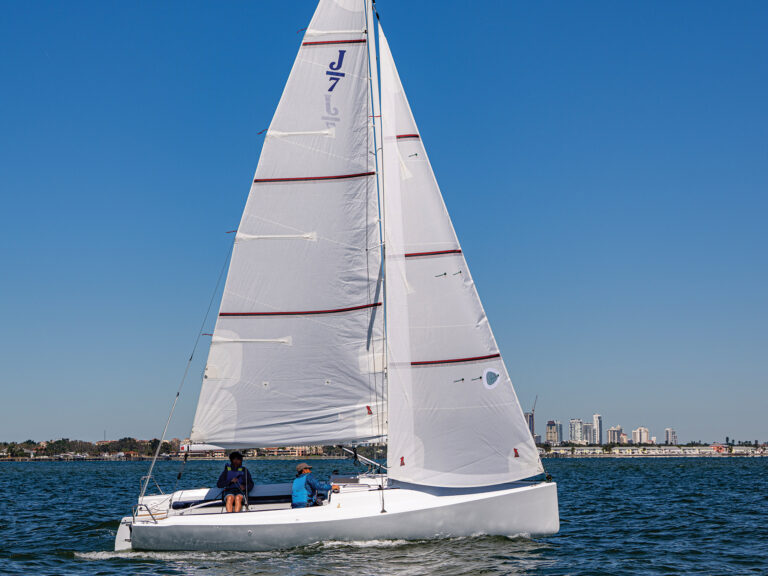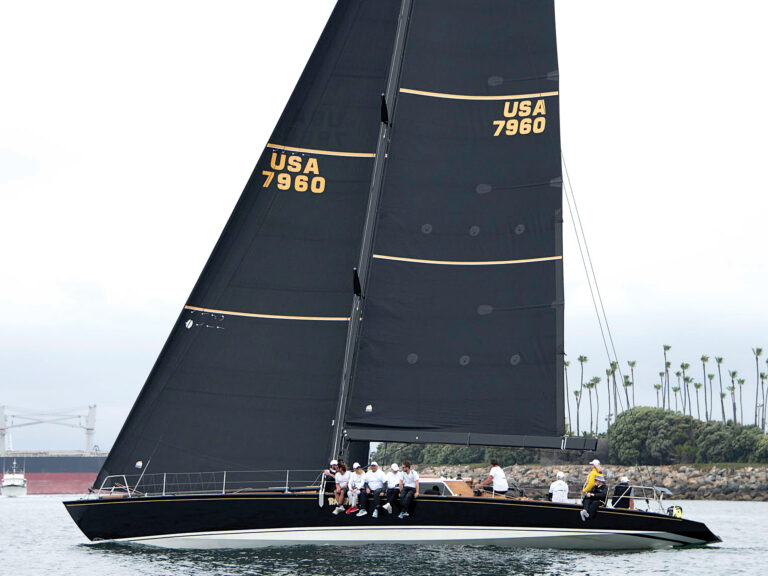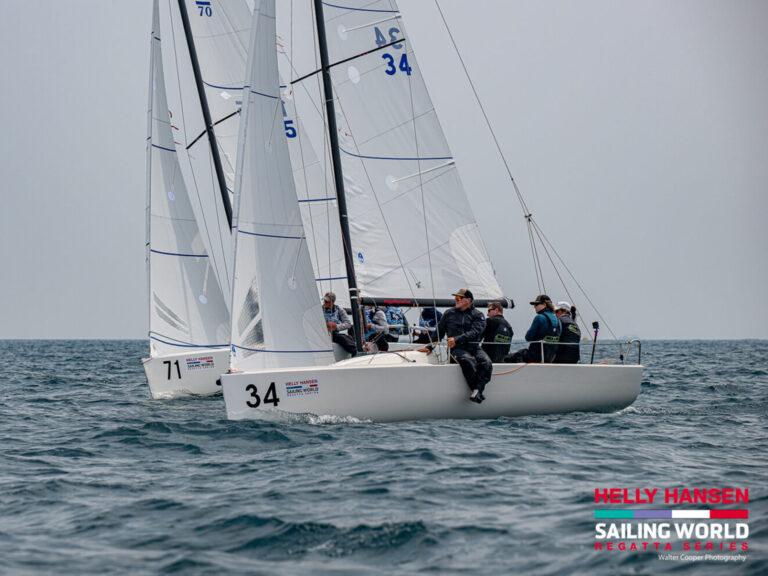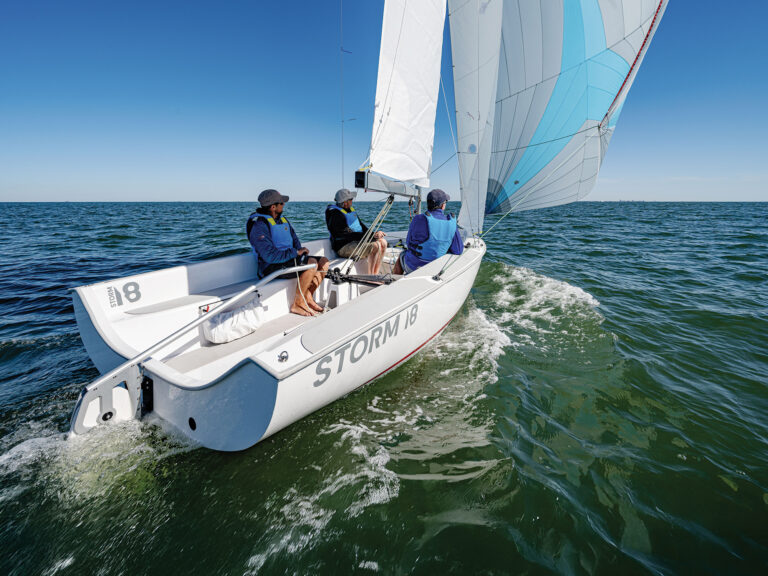
This second Thursday in January is a perfect Florida winter morning, the sort of weather the local chamber of commerce dials up regularly—a light easterly breeze barely ruffling the shallow, pristine waters of Sarasota Bay. Along the beach that fronts the busy Sarasota Sailing Squadron, there is commotion; like every early Thursday morn from September through May, several dozen seasoned gals known as the Luffing Lassies, almost all with their diverse and accomplished working lives in the rearview mirror—and none of whom will be remotely mistaken for college kids—are rigging up their prams, 420s and Sunfish for their weekly fix of sailboat racing. This particular Thursday, however, is somewhat different: It is the running of the 24th Annual Lilly Kaighan Memorial Regatta, so named for the Lassies’ founder, the somewhat obsessed sailing lady who came up with the idea for this organized madness in the first place—some five decades ago.
My introduction to this uncharted world is a fellow Rhode Island snowbird like myself, on hiatus from the New England winter for a few months. Before her recent retirement, Lee Parks was the inshore director at US Sailing for 33 years, but she’s also a lifelong Sunfish racer. “I never outgrew my junior boat,” she says. “The class has a culture that’s just phenomenal.”
She’d competed in midwinter Sunfish regattas in Sarasota many times and considered it a premier venue for dinghy racing, but she never knew about the Luffing Lassies until she inherited a property nearby, was introduced to the group, and quickly became one of them.
“They envelop you,” she says.
Lee loves the weekly competition but adds: “The biggest, best thing they do is bring in new people to the sport, teach them to sail, and give them an outlet to the water. They’re so welcoming.”
And so is she, inviting me to walk the beach while she makes some introductions.
So, thanks to Lee, there I find myself, chatting up the Lassies. And, oh my, what a story they have to tell. These days, there’s much hand-wringing from cranky old men like myself about the decline in sailboat racing. But here on the Gulf coast of Florida, where geezers abound, the Luffing Lassies and their 700 counterparts in the Florida Women’s Sailing Association, comprised of nine yacht clubs from Dunedin to Venice (the Salty Sisters from St. Petersburg, the Dinghy Dames from Davis Island, the Mainsheet Mamas from Tampa, the Windlasses from Dunedin, and so on) represent nothing less than a sailing renaissance, where they’re having trouble figuring out where the new members in the ever-expanding fleets will store their boats. They admit it’s a fine problem to have.
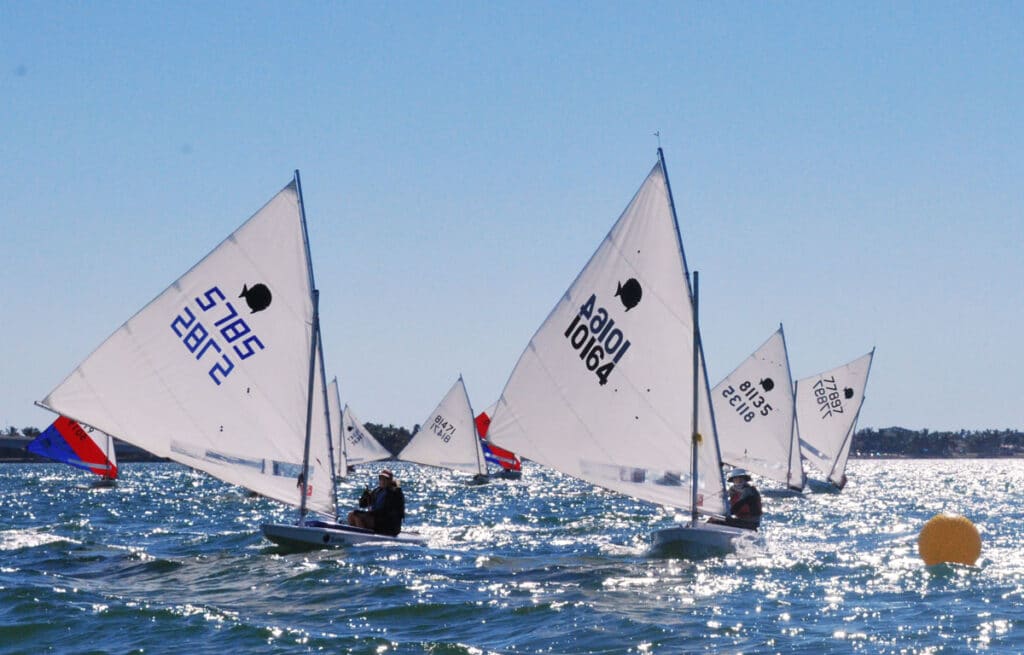
Is there something here that the Luffing Lassies can tell us about sailboat racing that perhaps should be obvious? Like, if you form a group that’s open, accommodating, friendly and supportive, and you invite just about anyone sharing the same mindset who wants to learn and challenge themselves, you can come up with something cool, unique and wonderful, where people dive in and thrive? As in, if you build it, they will come? The Lassies, I discover, in both their long history and unrivaled passion for sailing, have quite a bit to say about it all.
Ursula Olson has been there from the beginning, before the Luffing Lassies taught and introduced more than 500 women to the sport, back when it was originally known as the Sarasota Sailing and Sinking Society. “We used to capsize quite a bit,” she confesses.
Olson, who tells me she’s been a Lassie for 44 of the 50 years they’ve been in existence, says the organization was launched when Kaighan, a recent arrival from Tampa where she’d started a similar group, approached a handful of women about doing the same thing in Sarasota.
“She had two Clearwater Prams (a close cousin to the Opti) and said she had access to three more, so there were five boats,” Olson says. “Learning to sail was very attractive to many, including myself. The message always was: ‘Don’t worry, I’ll help you.’ She was absolutely the most accommodating, positive person. And she attracted those kinds of people. Some come and go quickly because they don’t want to mess up their hair or their fingernails. But that’s not who we are. There are about 90 Lassies today, ranging in age from their 30s to their 90s. Our 90-year-old still sails, not racing, but on a Hobie Wave we have for fun sailing. Everybody feels like they belong. It’s empowering. I’d say 95 percent of my friends are from this group. I’ve definitely found my tribe.”
That tribe, I soon learn, is an accomplished one, whose previous occupations include airline pilots, lawyers, doctors, even a federal judge. Then there’s Linda Schwartz, who joined the Lassies in 2009 after retiring to Sarasota following a career in the Army as a chief warrant officer.
“I was working out in the gym when somebody asked if I was interested in joining a women’s sailing group,” she says. “Yes, I was! I knew immediately when I walked in that this was for me. This isn’t mahjong; we’re a pretty Type A bunch. Actually, we’re a sisterhood. You put us all together, and we’re a force to be reckoned with.”
Schwartz, a former FWSA president with a solid mechanical background running Army maintenance units, has earned the nickname “Miss MacGyver.” She oversees the platoon of “Maintenance Mamas” who work on the 15 Sunfish the Lassies keep for training newcomers in the offseason summer months when they aren’t actively racing. Once the newbies get a season of racing under their belts, they generally procure their own boats, and the cycle repeats itself.
“We have a long-term planning committee now because we’ve gotten so big and are growing so much,” Schwartz says. “How do we manage it? We’re outgrowing the area we have at the Squadron. Our group has always been about word of mouth. The locals always knew. But now we’re getting more publicity, which means more women. It gets complicated.”
Once everybody is rigged and ready after a skipper’s meeting, which commences with laughter, stretching and calisthenics, I hop aboard the safety boat to observe the on-the-water action with a pair of the so-called “Starboard Studs” (everyone gets a nickname), the male volunteers from the Squadron who man the race committee and mark boats. “When the whole #metoo thing happened, they thought about changing our name,” says studly Pete Buros, one of the safety officers. “Instead, they gave us shirts with the name on it. They’re fun to wear in bars.” Buros intimates that they are excellent conversation-starters.
Before heading out, Lorri Kaighan—the daughter-in-law of founder Lilly, who succumbed to breast cancer at far too young an age—hands me a copy of the day’s schedule, which reads:
“The Lilly Kaighan Memorial Regatta is a special day for all Luffing Lassies. It celebrates its founder by having its members participate in a typical day of competition by racing in Clearwater Prams, a Sunfish or a 420. (The Prams and 420s had three boats each; with 30 boats, the Sunfish has become the group’s predominant class.) And the course is the original one that has been sailed by the Lassies for over 45 years: Modified Olympic (for the Sunfish and 420s) and Triangle for the Pram. It is a day filled with camaraderie, good competition, special trophies, and a luncheon to celebrate the day. The perpetual trophies were handmade by Lilly’s oldest son, Jim Kaighan, who resides in Marsh Harbour in the Bahamas. Lorri Kaighan made the individual trophies this year. And they were definitely made with a lot of love.”
With that, the fun begins.
Three races unfold, the first two in a light southeasterly, the third in a building westerly as the sea breeze kicks in. There is a disparity in prowess and efficiency on the starting line. A handful of competitors several rows deep seem not to have gotten the memo that there’d be racing today, which I realize is utterly beside the point. “Everyone who competes is a winner” is somewhat of a cliché, of course, but in this event, it is absolutely true. There are some midfleet clusters at the top mark, and some obvious fouls committed by the tail-enders, but not a raised voice to be heard. It’s all so…conversational and punctuated with laughter, so totally refreshing.
All that said, the sailing is crisp, clean and very, very competitive at the front of the busy Sunfish fleet. There is also a clear, dominant competitor, a mere wisp of a woman on a Sunfish called Wild Child named Lisa Brown Ehrhart, who runs away with the Memorial Regatta with three straight bullets.

Like every Lassie, it seems, Ehrhart has a unique background. Originally from the Virgin Islands, where her family ran a yacht-management business, for years she worked as a professional captain, delivering boats and skippering charters. Though she never raced sailboats in the islands, she says: “I had the gift of growing up on the water. There are many people who are better than me in terms of tactics, the chess game. But I do understand the water, as a surfer and windsurfer, and maybe that’s the only piece I have that’s a little different.”
When she moved to Florida so her kids could attend high school, she immersed herself in dinghy racing for the first time. “I needed to get on the water and sail, and I discovered the Lassies,” she says. “It was very humbling to start off with. But I’ve grown to love it. It’s the culture that’s so amazing. It’s like a Caribbean vibe, so relaxed.”
At 5 feet and 100 pounds, Ehrhart says the regatta’s two early light-air races played perfectly to her strengths. And she credits professional sailing coach Mike Ingham—whose wife, Delia, is a Lassie and recently organized a new Sunfish fleet at the Sailing Squadron—with “truly helping me develop my newly acquired racing skills.”
But, like every other Lassie I speak with, it is her fellow Luffing mates that really make the difference. “There are some really talented, amazing women here,” she says. “We learn from each other. We’re just really passionate about being here and sailing together.”
So, what to make of all this? It’s pretty simple. In these divisive days, when we fret about politics and the economy and every other bloody thing, at least one thing in this madcap, crazy world of ours is certain: The Lassies will be back at it next Thursday, bright and early.





